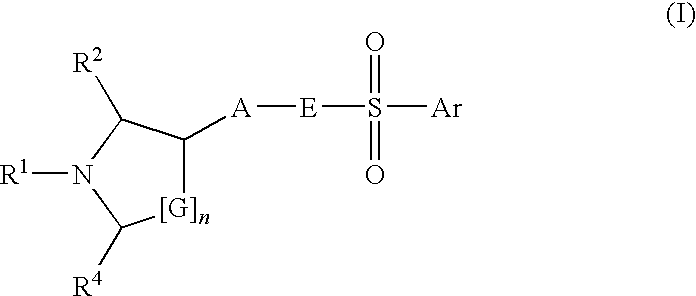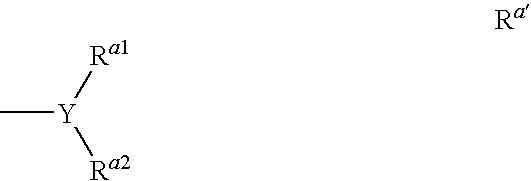Heterocyclic compounds suitable for treating disorders that respond to modulation of the dopamine D3 receptor
a heterocyclic compound and receptor technology, applied in the field of new drugs, can solve the problems of unsatisfactory pharmacological profile, affinity and selectivity of dsub>3 /sub>receptors
- Summary
- Abstract
- Description
- Claims
- Application Information
AI Technical Summary
Benefits of technology
Problems solved by technology
Method used
Image
Examples
preparation examples
I. Preparation of the Intermediates
a. Preparation of Sulfonyl Chlorides
a.1 4-((S)-2-Fluoro-1-methyl-ethyl)-benzenesulfonyl chloride
a.1.1 Toluene-4-sulfonic acid (S)-2-phenyl-propyl ester
[0178]To a solution of 20 g of (S)-(−)-2-phenyl-1-propanol in 240 ml of dichloromethane was added in portions 28 g of p-toluenesulfonyl chloride (146.8 mmol). After stirring for 18 h at room temperature, the organic phase was washed with 100 ml of water, dried over magnesium sulfate, filtered, and the solvent evaporated under reduced pressure to yield 43 g of the title compound.
[0179]1H-NMR (CDCl3, 400 MHz): δ [ppm] 7.65 (d, 2H), 7.15-7.3 (m, 5H), 7.1 (d, 2H), 4.0-4.1 (m, 2H), 3.1 (m, 1H), 2.4 (s, 3H), 1.3 (d, 3H).
a.1.2 ((S)-2-Fluoro-1-methyl-ethyl)-benzene
[0180]9.62 g of toluene-4-sulfonic acid (S)-2-phenyl-propyl ester (33.13 mmol) were dissolved in 80 ml of polyethylenglycol 400. 9.62 g of potassium fluoride (165.6 mmol) were added and the reaction mixture was stirred at 50° C. for 3 days and anot...
example 1
4-Isopropyl-N-[4-((S)-1-propyl-pyrrolidin-3-yl)-phenyl]-benzenesulfonamide hydrochloride
1.1 (S)-2-Phenyl-succinic acid dimethyl ester
[0231]5 g of (S)-2-phenyl succinic acid (25.75 mmol) were dissolved in 50 ml of methanol. At 4° C., 4.7 ml of thionyl chloride (64.37 mmol) were added dropwise. The reaction mixture was stirred at room temperature for 2 h, the solvents were evaporated under reduced pressure. The residue that remained was dissolved in diethyl ether, washed once with saturated aqueous NaHCO3 solution, reextracted with diethyl ether, and the combined organic layers dried over magnesium sulfate, filtered, and evaporated to dryness to yield 5.8 g of the desired product. ESI-MS: 223.1 [M+H]+
1.2 (S)-2-Phenyl-butane-1,4-diol
[0232]2.54 g of lithium aluminium hydride (66.95 mmol) were suspended under ice cooling in 25 ml of tetrahydrofuran. 5.8 g of (S)-2-phenyl succinic acid dimethyl ester (25.75 mmol) dissolved in 25 ml of tetrahydrofuran were added slowly at 5-10° C. Stirring...
example 2
4-(1,1-Dimethyl-propyl)-N-[4-((S)-1-Propyl-pyrrolidin-3-yl)-phenyl]-benzenesulfonamide hydrochloride
[0244]0.219 g of the desired product were obtained following the same synthetic procedure as described for 4-isopropyl-N-[4-((S)-1-propyl-pyrrolidin-3-yl)-phenyl]-benzenesulfonamide hydrochloride using commercially available 4-(1,1-dimethylpropyl)benzenesulfonylchloride.
[0245]ESI-MS: 415.5 [M+H]+
[0246]1H-NMR (DMSO-d6): δ [ppm] 11.3 and 11.1 (2 s, broad, 1H), 10.3 (m, 1H), 7.7 (d, 2H), 7.5 (d, 2H), 7.1-7.3 (m, 2H), 7.1 (m, 2H), 3.15-3.8 (several m, 4H), 2.85-3.15 (several m, 3H), 2.3 (m, 1H), 1.8-2.0 (m, 1H), 1.5-1.75 (several m, 4H), 1.2 (s, 6H), 0.9 (m, 3H), 0.55 (m, 3H).
PUM
| Property | Measurement | Unit |
|---|---|---|
| temperature | aaaaa | aaaaa |
| temperature | aaaaa | aaaaa |
| temperature | aaaaa | aaaaa |
Abstract
Description
Claims
Application Information
 Login to View More
Login to View More - R&D
- Intellectual Property
- Life Sciences
- Materials
- Tech Scout
- Unparalleled Data Quality
- Higher Quality Content
- 60% Fewer Hallucinations
Browse by: Latest US Patents, China's latest patents, Technical Efficacy Thesaurus, Application Domain, Technology Topic, Popular Technical Reports.
© 2025 PatSnap. All rights reserved.Legal|Privacy policy|Modern Slavery Act Transparency Statement|Sitemap|About US| Contact US: help@patsnap.com



